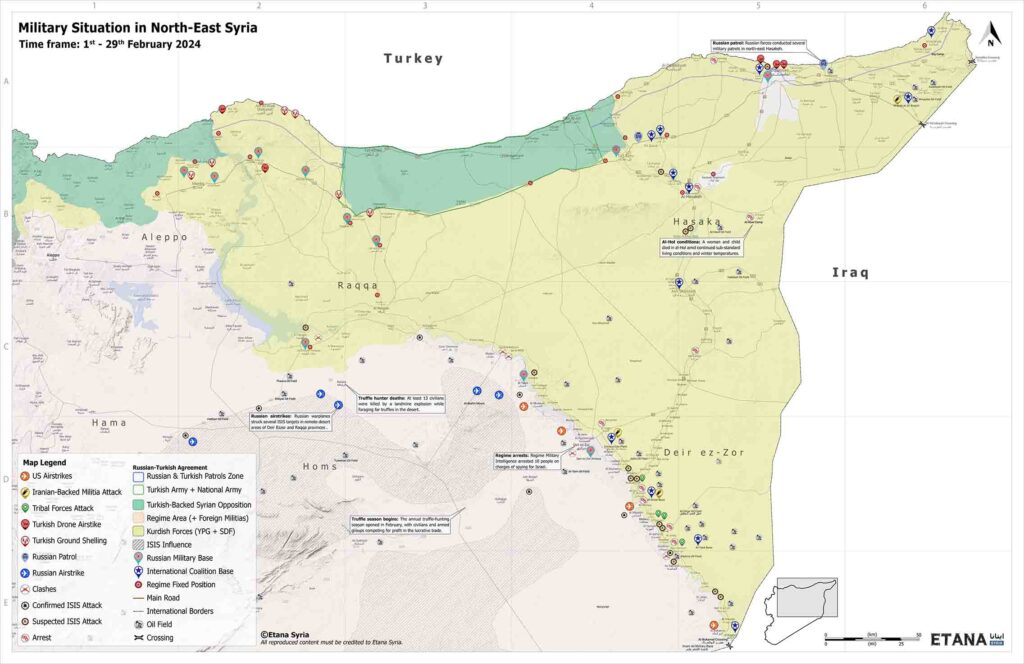ISIS attacks against the Syrian Democratic Forces (SDF) reached a new deadly peak in February. A security vacuum left by the SDF’s months-long conflict with Arab tribes in eastern Deir Ezzor and a simmering conflict with Turkey further north has created an ideal environment for ISIS to regroup and build strength. Though ISIS-perpetrated violence was already on the rise, the SDF has only more recently become the group’s primary target in the north-east. Other areas in the region also witnessed destabilizing violence perpetrated by different armed actors in February, the traditional beginning of the truffle-hunting season when thousands of people enter dangerous stretches of remote, loosely controlled desert in search of truffles and various armed groups––including regime units, Iranian-backed militias and ISIS cells––fight over control of this highly lucrative sector. In just the first weeks of the new season, more than a dozen civilians died after stepping on a landmine while several other civilians and combatants have simply vanished, likely killed or kidnapped by armed factions operating in remote stretches of the central Badia desert.
Attached Map:
Military Situation in North-East Syria
(For a high-resolution version of this map, please use the form at the bottom of the page)
ISIS Activity
ISIS attacks on SDF personnel, bases and other targets reached their highest rate in years this past February. Altogether, ISIS cells launched a total of 23 armed attacks and three IED blasts against SDF elements in Deir Ezzor, Hasakeh and Raqqa provinces. These attacks resulted in the confirmed deaths of 17 SDF troops while 21 others were injured, although it should be noted that a significant number of additional dead and wounded remain unconfirmed. This significant wave of attacks by ISIS was likely in response to several SDF-led campaigns that hurt the group’s logistical capabilities in the north-east.
In contrast to the surge in anti-SDF attacks, regime forces have faced few ISIS attacks. Etana recorded a total of four armed ambushes in Deir Ezzor, Hasakeh, Homs and Raqqa. These attacks claimed the lives of at least five regime troops.
The start of the annual desert truffle season in Syria has been accompanied by a notable surge in violent deaths across sparsely populated reaches of the central Badia region, as hundreds of civilians enter remote, loosely controlled areas of desert to search for truffles. Although revenues from the truffle trade are hotly and violently contested by various armed actors in the region (including ISIS, regime forces and Iranian-backed militias), ISIS has historically been a major presence in these areas, perpetrating horrific massacres against both civilian truffle-hunters and members of armed groups.
SDF Activity
SDF units arrested more than 26 people in February, including at least 16 suspected ISIS members. The number includes a large but unknown number of young men who were detained for the purposes of enforced conscription. At least one teenager was among those conscripted. The SDF also carried out significant raids in Deir Ezzor and Hasakeh provinces.
Russian & Regime Activity
In the central Badia, Russian forces have continued a largely ineffectual aerial campaign against ISIS forces, launching strikes against ISIS targets in remote desert regions around western Deir Ezzor and southern Raqqa. Russian forces conducted military patrols in northern Hasakeh.
Political & Humanitarian Developments
Landmines continue to pose a major problem for civilians and combatants alike in north-east Syria, inflicting indiscriminate injury and death upon local populations on an almost daily basis. In recent weeks, at least 10 individuals died from landmine explosions in Deir Ezzor and Raqqa. A large but unknown number sustained serious injuries, and several children were among the victims.
Ongoing violence, winter cold and sub-standard living conditions continue to regularly claim the lives of residents in Al-Hol camp. In recent weeks, two individuals—a woman and a child—died there. Last month, a delegation from Kyrgyzstan repatriated 99 women and children detained in Al-Hol.






